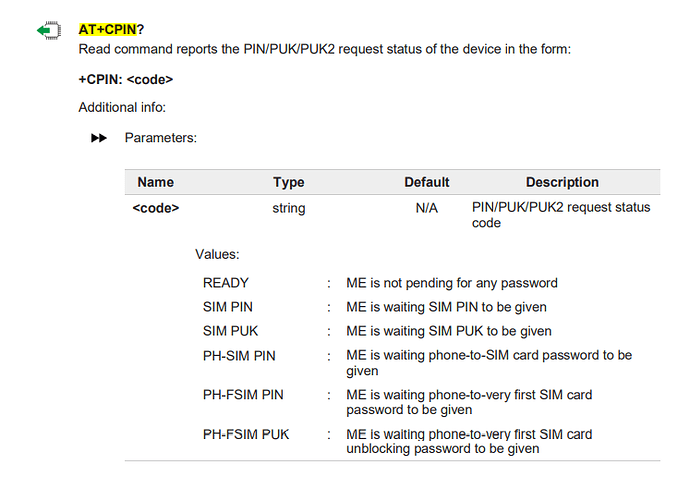I’m trying to set up an LTE hat with a Telit LE910C4 module ans a Vodafone SIM on my Raspberry Pi 4.
I followed this tutorial to set up a QMI based connection. Every step in the tutorial worked until I tried to connect.
pi@raspberrypi:~ $ sudo qmicli -p -d /dev/cdc-wdm0 --device-open-net=‘net-raw-ip|net-no-qos-header’ --wds-start-network=“apn=‘web.vodafone.de’,ip-type=4” --client-no-release-cid
error: couldn’t start network: QMI protocol error (14): ‘CallFailed’
call end reason (3): generic-no-service
verbose call end reason (3,2007): [cm] (null)
[/dev/cdc-wdm0] Client ID not released:
Service: ‘wds’
CID: ‘19’
Username and password are not needed. Vodafone germany uses two different APN’s for their SIM cards: web.vodafone.de and event.vodafone.de. Mine should be the first one, but I tried both with the same result. Also, entering complete nonsense for the APN yields the same result, so it’s problably not the credentials.
As the part generic in the error name says, it’s a pretty generic error description that doesn’t tell me anything about it’s cause.
Following, I’ll post what I think is important. If I’m missing anything, let me know.
AT
OK
ATE1
OK
ATI
332OK
AT+CGMR
M0F.670010OK
AT+CPIN?
+CPIN: SIM PINOK
AT+CPAS
+CPAS: 0OK
AT+CFUN?
+CFUN: 1OK
AT+COPS?
+COPS: 0OK
AT#USBCFG?
#USBCFG: 0OK
AT#BND?
#BND: 0,15,80800C5OK
AT+CREG?
+CREG: 0,0OK
AT+CGDCONT?
ERROR
AT+CSQ
+CSQ: 17,99OK
AT+CGATT?
ERROR
AT+GMM
LE910C4-EUOK
AT#SWPKGV
25.21.670-P0F.671803
M0F.670010
P0F.671803
A0F.670010
I’m pretty sure, the AT+CGDCONT? command shouldn’t yield ERROR, right? However, I can’t deduce any solution from that.
Bus 002 Device 001: ID 1d6b:0003 Linux Foundation 3.0 root hub
Bus 001 Device 003: ID 1bc7:1201 Telit Wireless Solutions
Bus 001 Device 002: ID 2109:3431 VIA Labs, Inc. Hub
Bus 001 Device 001: ID 1d6b:0002 Linux Foundation 2.0 root hub
pi@raspberrypi:~ $ lsusb -t
/: Bus 02.Port 1: Dev 1, Class=root_hub, Driver=xhci_hcd/4p, 5000M
/: Bus 01.Port 1: Dev 1, Class=root_hub, Driver=xhci_hcd/1p, 480M
|__ Port 1: Dev 2, If 0, Class=Hub, Driver=hub/4p, 480M
|__ Port 4: Dev 3, If 0, Class=Vendor Specific Class, Driver=option, 480M
|__ Port 4: Dev 3, If 1, Class=Vendor Specific Class, Driver=, 480M
|__ Port 4: Dev 3, If 2, Class=Vendor Specific Class, Driver=qmi_wwan, 480M
|__ Port 4: Dev 3, If 3, Class=Vendor Specific Class, Driver=option, 480M
|__ Port 4: Dev 3, If 4, Class=Vendor Specific Class, Driver=option, 480M
|__ Port 4: Dev 3, If 5, Class=Vendor Specific Class, Driver=option, 480M
|__ Port 4: Dev 3, If 6, Class=Vendor Specific Class, Driver=option, 480M
pi@raspberrypi:~ $ sudo qmicli -d /dev/cdc-wdm0 --wda-get-data-format
[/dev/cdc-wdm0] Successfully got data format
QoS flow header: no
Link layer protocol: ‘raw-ip’
Uplink data aggregation protocol: ‘disabled’
Downlink data aggregation protocol: ‘disabled’
NDP signature: ‘0’
Uplink data aggregation max size: ‘0’
Downlink data aggregation max size: ‘0’
Thanks in advance.

